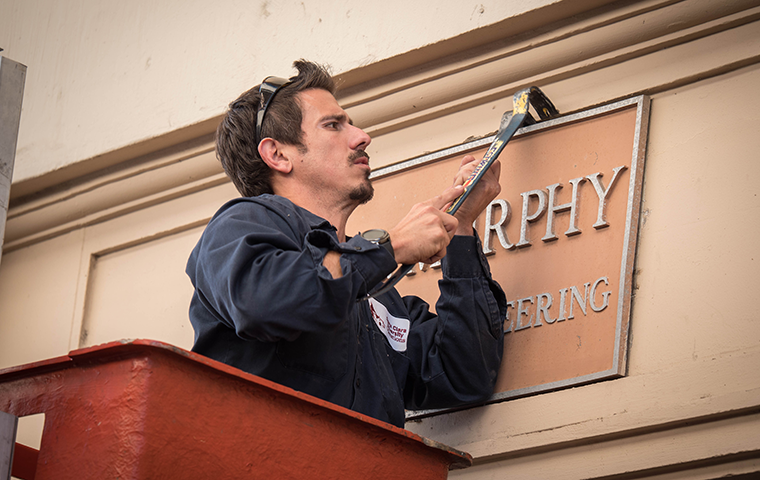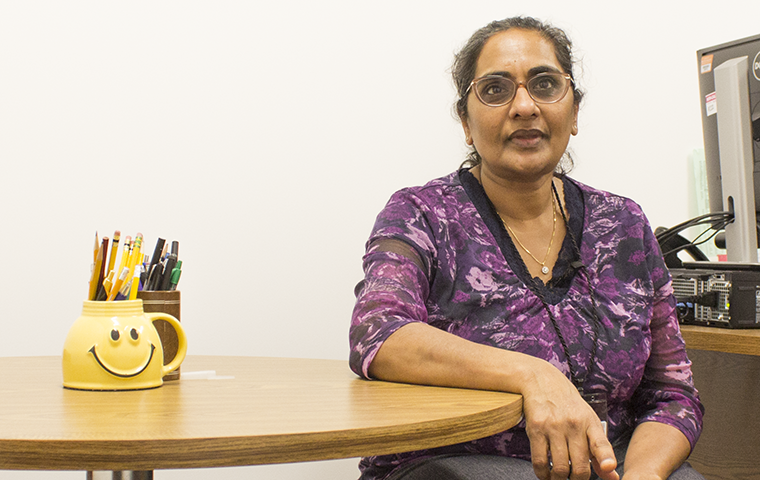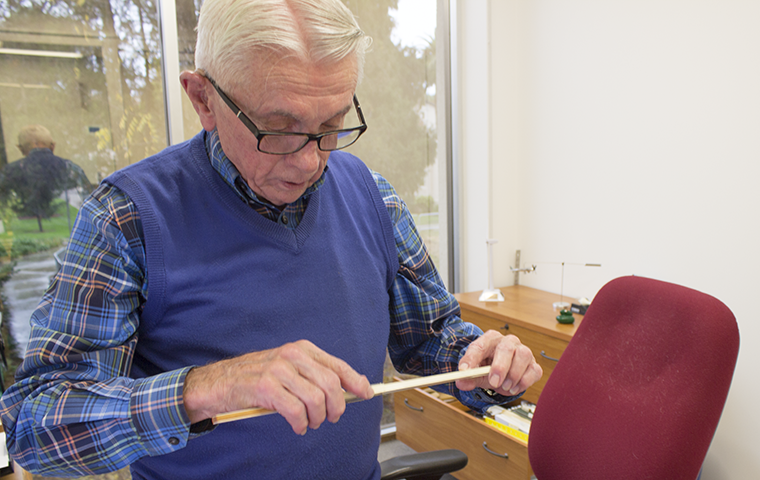
If These Walls Could Talk
Lauren Loftus
Tracing time and stories through recycled office furniture at the new home of engineering in Heafey Hall.
The round table in engineering Professor Shoba Krishnan’s new office is no bigger than an extra-large pizza. But its size belies its importance to the ecosystem of this small room in the old Heafey Law Library. Like a kitchen table passed down through generations, or a psychiatrist’s leather armchair, the particle board table—surrounded by not-exactly-comfy plastic red chairs—is home to countless stories.

Engineering Professor Shoba Krishnan sits at the small table where she meets with students one-on-one in her office. Photo by Lauren Loftus
The table isn’t the same one that was in her old office in Bannan Engineering, but it was important a replacement made it to her new office. This one, a little smaller than her last, was recycled from elsewhere on campus. Her future students’ inevitable sob stories and declarations of achievement will be added to its inventory.
“I couldn’t care less about the furniture or where it comes from. The only thing I asked for in this move were my two bookshelves and this table to meet with students one-on-one,” she said. “I was one of the first faculty to ask for a small meeting table—not because I’m so wonderful, but because my desk was always such a mess that I couldn’t write on it and talk to students at the same time.”
“Whenever people ask me what they should do to succeed in college,” Krishnan said, “I always say, ‘No matter what else you do, always go see your professors in their offices.”
There, you’ll find a seat at the table. Any table will do.
A Sustainable Endeavor
In order to make room for the Sobrato Campus for Discovery and Innovation, Krishnan’s office—and the rest of engineering’s former home in Bannan Engineering Center as well as its laboratories—are being torn dorn.
The state-of-the-art, 300,000-square-foot complex is slated for completion in 2022. To make room for construction crews, faculty and staff moved over winter break to various temporary homes on campus. Most found themselves in Heafey and Bergin Halls, which previously housed the School of Law and Law Library and underwent a heavy remodel in 2018 to accommodate the unique needs of engineering faculty and students, including classrooms, labs, and an airy community lounge with individual and group study tables.
When facilitating the remodel and move, University Operations (UO) was tasked with competing endeavors of needing to modernize the connecting buildings—built in 1962 and 1939, respectively—and reuse materials and furniture from Bannan and elsewhere across campus to be as sustainably conscious as possible.
UO project manager Marissa Pimentel, ’10 MBA ’15 compared the move to the trickiest 1,000-piece jigsaw puzzle: "My furniture from my old office might not fit into my new office, but it’ll fit into yours,” she said. “It’s all based on the fit, because the new offices are shaped very differently.”
That means most faculty got to keep small bookcases but got new desks, file cabinets, and chairs. Well, “new” insomuch as a reused, bulky, L-shaped pine desk with rounded edges from the ’80s and ’90s can be. “We’re repurposing a lot of the furniture from the old buildings,” said Don Akerland, UO director of planning and projects. “Whatever we couldn’t fit but that’s still usable is going into a warehouse, and we’ll see if there’s use for it elsewhere in the University; or it’ll be donated.”
SCU works with IRN, or International Reuse Network, which matches unneeded furniture and equipment from the U.S. with educational and housing facilities in developing countries. “They literally come in, pack up containers with what they want, ship it out, and we recycle the rest,” said Pimentel.
As for the Bannan buildings themselves, Ackerland said, “We try and reuse as much as we can.” That means roof tiles on Bannan that are still usable will be sprinkled atop the new STEM building in order to maintain a cohesive architectural style on campus. Keycard-locking doorknobs are being reused in the new building, as are cabinet hardware. And room-naming plaques and tiles from past donors are being stored while designs are finalized, along with high-tech equipment for classrooms and labs.
“This equipment is high-value and doesn’t go out of style in three years,” Pimentel said of the computers, microscopes, incubators, lasers, circuit boards, and a working wind tunnel that made the move along with squeaky rolling chairs and—since it’s a college campus—copious coffee mugs.
“People tend to accumulate a lot of stuff over the years,” she said, so University Operations worked with the Center for Sustainability to implement its zero waste initiative throughout the remodel and move process. It’s all about downsizing, purging, and recycling a surplus of supplies, Pimentel explained. “So, we encouraged faculty to go through their drawers and cabinets to say, ‘Wait, why do I have 17 coffee mugs when I probably only need three?’” Those supplies then go to organizations like RAFT, which provides donated and recycled supplies at discounted prices to area teachers.
In total, the School of Engineering collected 2,142 pounds of supplies to recycle—from binders to hanging file folders— over the course of the move, according to Center for Sustainability director Lindsey Kalkbrenner.
What Makes an Office
Engineering Professor Tim Healy really likes his new office window in Heafey. It certainly is a nice one: The entire back wall is a floor-to-ceiling pane of glass overlooking the zig-zagging grassy paths and fat leafy trees consuming the west end of campus.

Electrical Engineering Professor Tim Healy demonstrates how to use his old slide rule, which he used instead of a calculator when first starting at SCU 52 years ago. Photo by Lauren Loftus
“It depends on if they’re on time [for construction] or if I make it that long,” Healy said with a self-effacing smile. “If I do, I’ll be 89 years old.”
Through his various office windows, though, he’s witnessed a lot: the influx of women arriving on campus, and dozens of construction projects. His first office even overlooked the site where the Bannan Engineering Center went up in 1973. “I always regretted not putting up a camera on a timer that ran every several hours for a year and a half to get a movie of that building going up block by block.”
But there are other ways to track the progress of SCU and Silicon Valley’s technological revolution infiltrating his classroom walls: relics of offices past that have no practical use these days.
“Do you know what this is?” he asked slyly, producing what looked like a long, thick ruler from a worn leather pouch that few under the age of 60 would recognize. “It’s a slide rule—like a calculator but not as accurate. I can tell you what the square root of 37 is or what 5 times 9 is. When I was going to school for engineering, if you went back 75 years, you’d see all these geeks running around with one of these hooked to their belt loops … Most of the 20th century was built with slide rules.”
A University Operations employee removes a plaque on the Mechanical Engineering Building during the School of Engineering's move to Heafey Hall in December 2018. Photo by Charles Barry.